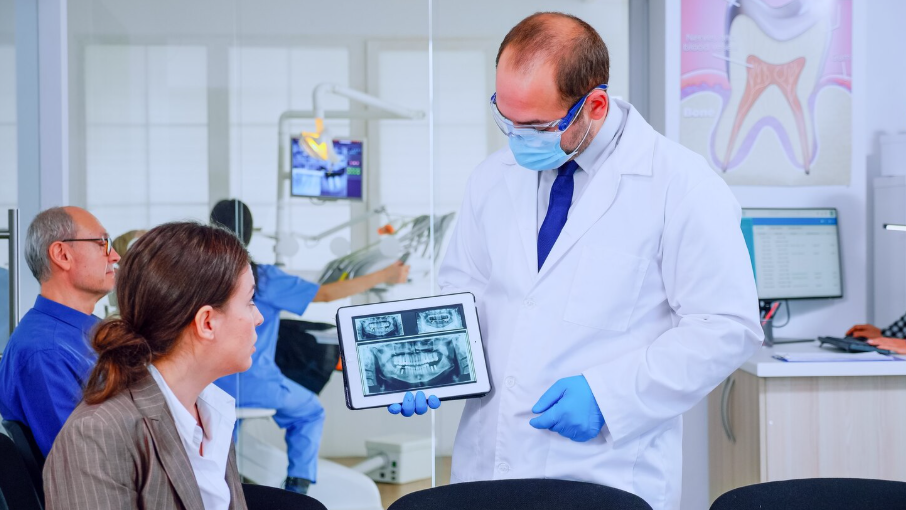The Role of Dental Radiology Services in Detecting Hidden Oral Problems

Maintaining good oral health is not only about brushing, flossing, or visiting your dentist regularly — it’s also about what lies beneath the surface. Many dental problems develop silently, hidden deep within the teeth, gums, or jawbone. These underlying issues often go unnoticed during routine checkups until they progress into painful or costly conditions. That’s where Dental Radiology Services become an essential part of modern dental care.
Dental radiology allows dentists to see beyond the visible layers of the mouth. Using advanced imaging tools such as digital X-rays, panoramic imaging, and cone beam CT scans, dentists can identify problems that traditional examinations may miss. This early detection enables timely treatment, better accuracy, and more effective prevention of oral diseases.
Understanding Dental Radiology and Its Importance
Dental Radiology Services refer to the use of imaging technologies to examine teeth, jawbones, and surrounding oral structures. These images help dentists diagnose a wide range of conditions — from cavities and bone loss to infections, cysts, and tumors. In fact, many dental treatments today would be incomplete or inaccurate without radiographic support.
Radiology plays a vital role not only in diagnosing diseases but also in guiding treatment procedures. Before dental implants, orthodontic adjustments, or extractions, radiology helps determine the exact shape, position, and density of the bone and teeth. This ensures safer procedures and better results.
Moreover, radiology helps detect abnormalities that patients often overlook — such as small lesions, fractures, or sinus-related issues that affect dental health. By catching these conditions early, dentists can recommend appropriate treatment before they worsen.
Different Types of Dental Radiology Services
The field of Dental Radiology Services has evolved significantly with the advancement of digital technology. Here are the main types of imaging methods used in dental care today:
-
Intraoral X-Rays
These are the most common dental X-rays taken inside the mouth. They provide detailed images of each tooth and help detect cavities, assess root health, and monitor bone levels supporting the teeth. -
Bitewing X-Rays
Bitewing images show both upper and lower teeth in one area of the mouth, making it easier to detect decay between teeth or check for bone loss caused by gum disease. -
Periapical X-Rays
These focus on one or two teeth at a time, showing the entire tooth from crown to root, along with the surrounding bone. They’re useful in diagnosing abscesses, cysts, and root infections. -
Panoramic X-Rays
A panoramic image captures the entire mouth in a single shot — teeth, jawbones, temporomandibular joints (TMJ), and sinuses. Dentists use this type of X-ray to identify impacted teeth, tumors, or structural problems in the jaw. -
Cone Beam Computed Tomography (CBCT)
The CBCT scan is an advanced 3D imaging system that provides detailed, cross-sectional views of the mouth. It’s especially valuable in dental implant planning, orthodontic assessments, and evaluating complex root canal cases.
Each of these techniques serves a unique diagnostic purpose, ensuring that every dental issue is accurately identified and properly addressed.
How Dental Radiology Services Detect Hidden Oral Problems
Many oral health conditions begin in areas that cannot be seen or felt. Cavities may start between teeth, infections may develop inside the roots, and bone loss may progress under the gums. With Dental Radiology Services, dentists can detect these hidden issues before they cause visible damage or pain.
For example:
-
Tooth decay: Early cavities can form beneath fillings or in between teeth — areas that visual inspection cannot reveal.
-
Bone loss: Radiographs can show the extent of bone deterioration due to gum disease.
-
Infections: Dental abscesses or cysts beneath the roots are clearly visible through X-rays or CBCT scans.
-
Impacted teeth: Especially in the case of wisdom teeth, panoramic X-rays can show whether teeth are trapped beneath the gums or growing at odd angles.
-
Tumors and cysts: Occasionally, radiology can detect unusual growths or bone changes that could indicate serious health issues.
Without dental imaging, these hidden conditions might remain undetected until they reach an advanced, painful, or expensive stage of treatment.
The Role of Technology in Modern Dental Radiology
Advances in technology have made Dental Radiology Services faster, safer, and more accurate than ever before. Digital radiography has replaced traditional film-based X-rays, offering clearer images, lower radiation doses, and instant results.
Digital systems also allow for image enhancement — dentists can zoom in, adjust contrast, and share results electronically with specialists if needed. Cone Beam CT scanners, in particular, have revolutionized dental diagnostics by providing 3D visualizations of oral structures. This precision helps in complex treatments such as implant placement, root canal therapy, and reconstructive surgery.
Additionally, digital radiology supports sustainable practices by eliminating the need for chemical processing and film storage, making dental imaging more eco-friendly and efficient.
Safety and Radiation Concerns in Dental Imaging
One of the most common concerns patients have about Dental Radiology Services is radiation exposure. However, with modern equipment, the amount of radiation used in dental X-rays is extremely low — often less than what you are naturally exposed to in a day.
Dentists follow strict safety protocols, including using lead aprons and thyroid collars, to ensure maximum protection. The benefits of early detection and accurate diagnosis far outweigh the minimal risks associated with dental imaging. Moreover, digital systems use up to 80% less radiation compared to traditional methods, making them safe for both adults and children.
Applications Beyond Diagnosis
Dental Radiology Services are not limited to detecting problems — they are equally crucial in treatment planning and monitoring. For example:
-
Before dental implant placement, radiology helps assess bone density and position to ensure the best possible outcome.
-
During orthodontic treatment, imaging helps monitor tooth movement and jaw alignment.
-
In endodontics (root canal treatment), radiology confirms the shape and number of root canals and helps verify successful treatment afterward.
Even after treatment, follow-up X-rays help monitor healing and ensure that restorations or implants are stable and functioning correctly.
The Dentist’s Expertise in Radiographic Interpretation
Having high-quality images is only part of the equation — expert interpretation is what truly makes Dental Radiology Services valuable. Dentists and oral radiologists are trained to identify subtle changes in bone texture, density, or tooth structure that might indicate disease or infection.
Their ability to interpret these details ensures that no abnormality is overlooked. This expertise allows for early intervention, which can prevent tooth loss, infection spread, or other complications.
Conclusion
In modern dentistry, Dental Radiology Services are indispensable tools for ensuring comprehensive and accurate oral care. They reveal what lies beneath the surface, enabling dentists to detect hidden issues before they escalate into serious problems.
From simple cavity detection to advanced 3D imaging for complex surgeries, dental radiology supports every step of diagnosis and treatment. With safe, efficient, and precise imaging technologies, patients can rest assured that their dental health is in expert hands.
By embracing these services, both dentists and patients take a proactive approach to oral health — one that prioritizes early detection, effective prevention, and lasting smiles.






